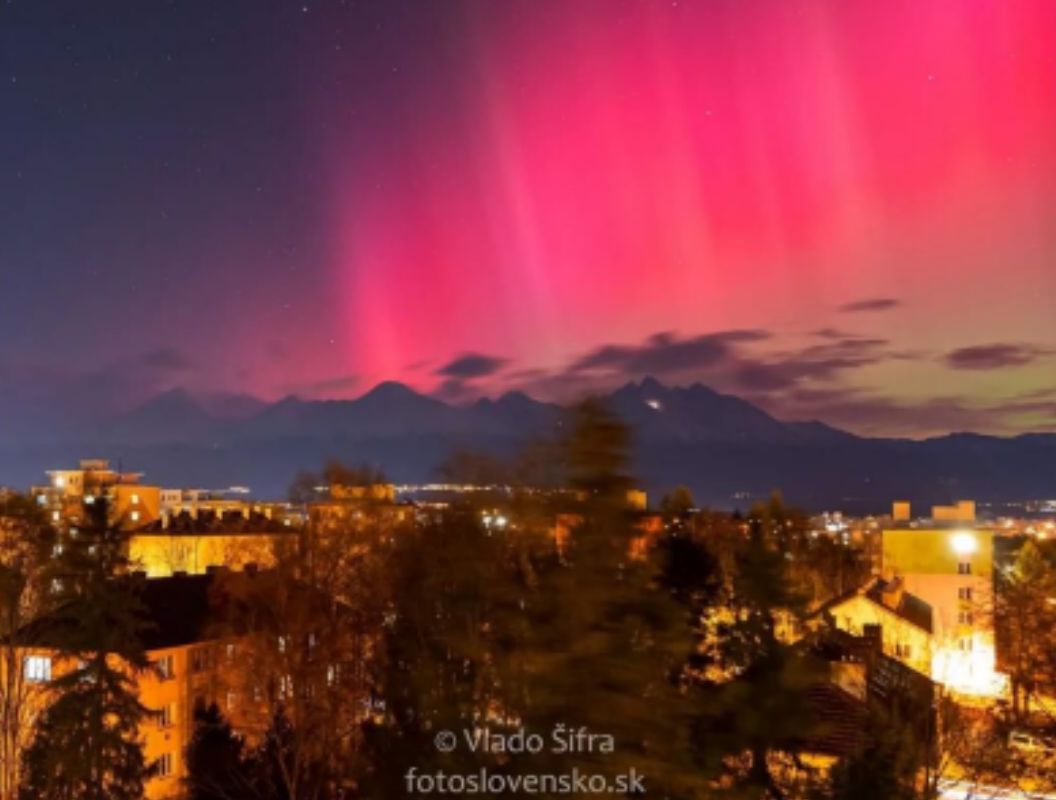Northern lights above Lomnický štít. How the neutron detector saw it

Northern lights, also known as aurora borealis (in the northern latitudes) or aurora australis (in the southern latitudes) is a natural phenomenon that occurs when high-energy particles of cosmic rays penetrate the upper layers of the atmosphere (thermosphere/exosphere). Depending on their energy, some of the most common interactions in the atmosphere are the excitation or ionization of an air molecules. The aurora itself then arises as a result of the deexcitation and deionization of air molecules, and its intensity depends on the flow of particles that managed to overcome the protective shield of the Earth’s magnetic field.
The Earth’s magnetic field acts as a shield against cosmic radiation, which consists almost exclusively of high-energy charged particles. Its shading ability is weaker near the poles and reaches maximum values in equatorial regions. This is why we can commonly see the aurora borealis in the northern and southern regions of the Earth, and why the polar lights are rare in the mid-latitude regions.
Nevertheless, there are solar phenomena that can cause disturbances in the Earth’s magnetic field and weaken its shielding abilities in the mid-latitude and equatorial regions.
One of the most important events of this type is the so-called is Coronal Mass Ejection (CME). A CME is a significant ejection of solar plasma from the Sun’s corona. Simply put, when a stream of particles ejected from the Sun hits the Earth’s magnetosphere, its ability to shield the Earth from cosmic rays decreases and allows cosmic ray particles, including those contained in CMEs, to enter the upper atmosphere, sometimes even in mid-latitude regions.
Slovakia is one of the European countries that lie in the mid-latitude regions. Observing the Northern lights in Slovakia is very rare, but it does occur. Most likely this also happened during the evening of November 5, 2023, when many people throughout Slovakia watched the sky in amazement, because its northeastern part had just turned purple-pink, including the region above Lomnický štít.
However, it would be appropriate to support the claim about the observed Norther lights from this evening with some other observation that would prove that a CME event occurred on the Sun shortly before the appearance of the aurora. So is there any other evidence that could support this assumption? Fortunately, yes. CME can be observed in many ways such as, for example, by means of specially designed satellites orbiting the Earth, solar telescopes located on the Earth or by very interesting device that we also have in Slovakia – a standard neutron monitor.
In the second half of the 20th century, based on the worldwide scientific suggestions from experts in the field of particle physics and cosmic radiation, an initiative was created to create a worldwide network currently composed of more than 50 standard neutron monitors located in various regions of the Earth (data for most of them are available HERE). One of the countries involved in this initiative through its scientists was the former Czechoslovak Socialist Republic, which placed its neutron monitor in the scientific part of the observatory on Lomnicky štít, where it is still operated by the Institute of Experimental Physics SAS.
Standard neutron monitor is an instrument for measuring secondary neutrons that are produced in the Earth’s atmosphere as a result of nuclear reactions between primarily charged protons and atmospheric molecules of air. Neutrons are actually one of the many products of cosmic ray interactions occurring in the atmosphere. It should be noted that the standard neutron monitor on the Lomnický štít is the 8NM64 type and has been operating continuously since December 1981. It is not a small and light device, it has the shape of a cuboid with dimensions of 4m x 2.4m x 0.5m and contains about 12 tons of lead.
How it happened on November 5, 2023
The stream of secondary neutrons measured by the neutron monitor on the Lomnicki štít is shown on the graph in the image section. We observe an increase in the flow of secondary neutrons, which starts at approximately 10AM and reaches its maximum at noon. This maximum is a result of the interaction of the high – energy particles from the CME that entered the Earth’s atmosphere. Northern lights was not visible only because the daylight was more intense than the aurora. Later in the evening, the CME particles did not have enough energy to increase the secondary neutron flux in the atmosphere, so we do not observe a similar peak in the evening. However, given the typical CME time and energy spectrum profiles, we can conclude that the evening aurora was a consequence of a CME event captured by the neutron monitor at noon.
Therefore, it can be concluded that on November 5, 2023, we observed not only the Northern lights in the Slovak sky and over the Lomnický štít, but also an increase in the secondary neutron flux due to a massive CME from the Sun.
The video shows the CME before November 5, 2023, as captured by the SDO / AIA and SOHO / LASCO instruments.
Text: Ján Kubančák et. al., Institute of Experimental Physics SAS
Photo: IEP SAS, Vladimír Šifra and NMDB
Video: https://helioviewer.org/
 Contact
Contact Intranet
Intranet SK
SK






